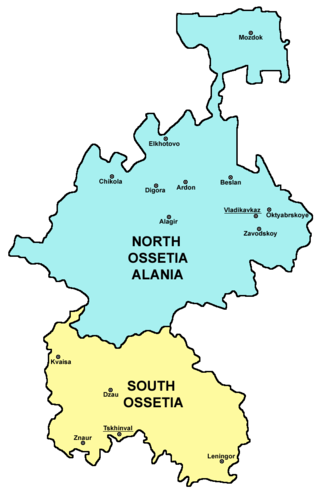
Ossetia is an ethnolinguistic region located on both sides of the Greater Caucasus Mountains, largely inhabited by the Ossetians. The Ossetian language is part of the Eastern Iranian branch of the family of Indo-European languages. Most countries recognize the Ossetian-speaking area south of the main Caucasus ridge as lying within the borders of Georgia, but it has come under the control of the de facto government of the Russian-backed Republic of South Ossetia – the State of Alania. The northern portion of the region consists of the, Republic of North Ossetia-Alania within the Russian Federation.

South Ossetia, officially the Republic of South Ossetia or the State of Alania, is a partially recognised landlocked country in the South Caucasus. It has an officially stated population of just over 56,500 people (2022), who live in an area of 3,900 square kilometres (1,500 sq mi), with 33,000 living in the capital city, Tskhinvali.

The republics are one type of federal subject of the Russian Federation. 21 republics are internationally recognized as part of Russia; another is under its de facto control. The original republics were created as nation states for ethnic minorities. The indigenous ethnicity that gives its name to the republic is called the titular nationality. However, due to centuries of Russian migration, a titular nationality may not be a majority of its republic's population. By 2017, the autonomous status of all republics was formally abolished, making the republics politically equivalent to the other federal subjects of Russia.
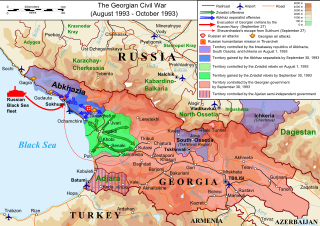
The Georgian Civil War lasted from 1991 to 1993 in the South Caucasian country of Georgia. It consisted of inter-ethnic and international conflicts in the regions of South Ossetia and Abkhazia, as well as the violent military coup d'état against the first democratically-elected President of Georgia, Zviad Gamsakhurdia, and his subsequent uprising in an attempt to regain power.

The Abkhazia conflict is a territorial dispute over Abkhazia, a region on the eastern coast of the Black Sea in the South Caucasus, at the intersection of Eastern Europe and Western Asia. The conflict involves Georgia, the Russian Federation and the Russian-backed self-proclaimed Republic of Abkhazia, which is internationally recognised only by Russia, Venezuela, Nicaragua, Nauru, and Syria; Georgia and all other United Nations members consider Abkhazia a sovereign territory of Georgia. However, as of 2023, Georgia lacks de facto control over the territory.

The Georgian–Ossetian conflict is an ethno-political conflict over Georgia's former autonomous region of South Ossetia, which evolved in 1989 and developed into a war. Despite a declared ceasefire and numerous peace efforts, the conflict remained unresolved. In August 2008, military tensions and clashes between Georgia and South Ossetian separatists erupted into the Russo-Georgian War. Since then, South Ossetia has been under a de-facto Russian control.

The South Ossetian Autonomous Oblast was an autonomous oblast of the Soviet Union created within the Georgian SSR on April 20, 1922. It was an ethnic enclave created for the Ossetians within Georgia by Soviets as a reward for their political loyalty during the 1921 Soviet invasion of Georgia. Its autonomy was revoked on December 11, 1990 by the Supreme Council of the Georgian SSR after illegally holding rival elections, leading to the First South Ossetian War. Currently, its territory is controlled by the breakaway Republic of South Ossetia.

South Ossetia, a mostly unrecognized republic in the South Caucasus, formerly the South Ossetian Autonomous Oblast within the Georgian Soviet Socialist Republic with its capital in Tskhinvali, held a referendum on independence on November 12, 2006.
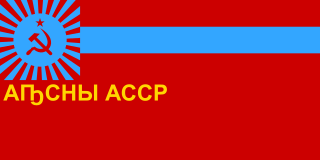
The Abkhaz Autonomous Soviet Socialist Republic, abbreviated as Abkhaz ASSR, was an autonomous republic of the Soviet Union within the Georgian SSR. It came into existence in February 1931, when the Socialist Soviet Republic of Abkhazia, originally created in March 1921, was transformed to the status of Autonomous Soviet Socialist Republic within the Georgian SSR.

Torez Georgievich Kulumbegov, was a political leader of South Ossetia.

The 1991–1992 South Ossetia War was fought between Georgian government forces and ethnic Georgian militias on one side and the forces of South Ossetian separatists and Russia on the other. The war ended with a Dagomys Agreement, signed on 24 June 1992, which established a joint peacekeeping force and left South Ossetia divided between the rival authorities.
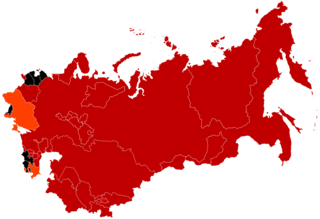
The New Union Treaty was a draft treaty that would have replaced the 1922 Treaty on the Creation of the Union of Soviet Socialist Republics (USSR) to salvage and reform the USSR. A ceremony of the Russian SFSR signing the treaty was scheduled for 20 August 1991 but was prevented by the August Coup a day earlier.

An independence referendum was held in the Republic of Georgia on 31 March 1991. It was approved by 99.5% of voters.

This article describes the background of the Russo-Georgian War.
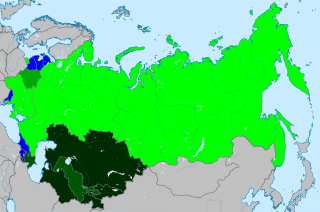
A referendum on the future of the Soviet Union was held on 17 March 1991 across the Soviet Union. It was the only national referendum in the history of the Soviet Union, although it was boycotted by authorities in six of the fifteen Soviet republics.

The Georgia–South Ossetia separation line is a de facto boundary set up in aftermath of the 1991–1992 South Ossetia War and Russo-Georgian War, which separates the self-declared Republic of South Ossetia from the territory controlled by the Government of Georgia. South Ossetia, and those states that recognise its independence, view the line as an international border separating two sovereign states, whereas the Georgian government views it as an occupation line in accordance with the Georgian "Law on Occupied Territories of Georgia". The Constitution of Georgia does not recognize South Ossetia as having any special status within Georgia, therefore the line does not correspond to any Georgian administrative area, with the territory claimed by the Republic of South Ossetia shared out amongst several Georgian Mkhares: Shida Kartli, Imereti, Racha-Lechkhumi and Kvemo Svaneti and Mtskheta-Mtianeti.

South Ossetia is a partially recognized and Russian-occupied separatist state internationally recognized as part of Georgia. It is mainly inhabited by Ossetians, an ethnic group also dominant in North Ossetia, which is part of Russia. South Ossetia separated itself from Georgia following the 1991–1992 South Ossetia War with the help of Russia, remaining ever since as a state closely allied with this country.

With the dissolution of the Soviet Union and Ukrainian independence the majority ethnic Russian Crimean peninsula was reorganized as the Republic of Crimea, after a 1991 referendum with the Crimean authorities pushing for more independence from Ukraine and closer links with Russia. In 1995 the Republic was forcibly abolished by Ukraine with the Autonomous Republic of Crimea established firmly under Ukrainian authority. There were also intermittent tensions with Russia over the Soviet Black Sea Fleet, although a 1997 treaty partitioned the Soviet Black Sea Fleet allowing Russia to continue basing its fleet in Sevastopol with the lease extended in 2010. Following the impeachment of the relatively pro-Russia Ukrainian President Viktor Yanukovych, Russia invaded Crimea, overthrew the elected autonomous government and claimed to annex it in 2014.

The Administration of South Ossetia, officially the Administration of the temporary Administrative-Territorial Unit on the Territory of the Former Autonomous Region of South Ossetia, is an administrative division that Georgia regards as the legal government of South Ossetia. The administration was set up by the Georgian government as a transitional measure leading to the settlement of South Ossetia's status. The area lies within the territory of the former South Ossetian Autonomous Oblast which was abolished by the Georgian government in 1990. Since then South Ossetia has no formal autonomous status within Georgia.

Supreme Soviet elections were held in the South Ossetian Autonomous Oblast on 9 December 1990. The disputed elections took place during a period of extreme ethnic unrest in Georgia during the collapse of the Soviet Union. South Ossetia declared independence from Georgia and held elections in response to regional political parties being barred from the 1990 Georgian Supreme Soviet election. In response, Georgia declared martial law, which culminated in the start of the South Ossetian War.


















